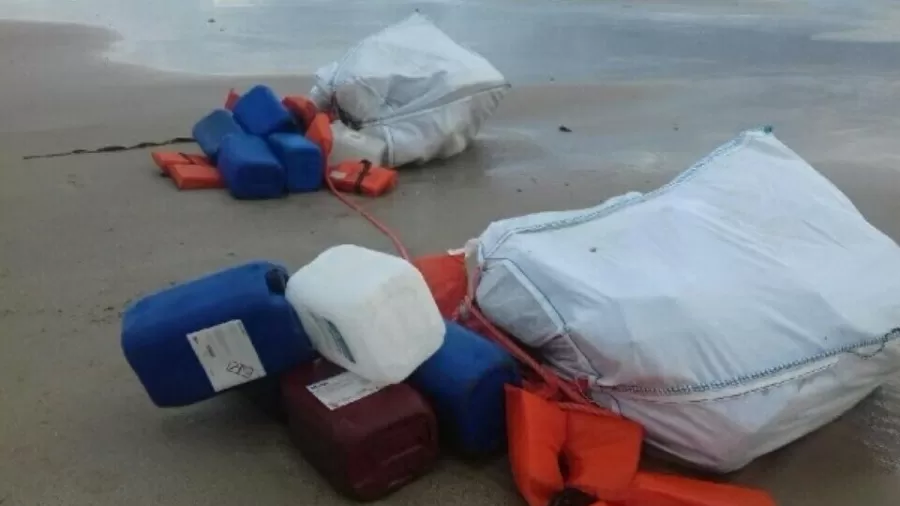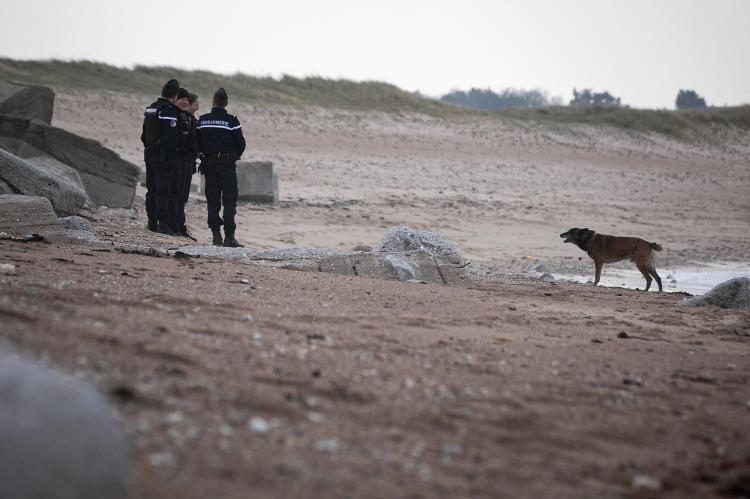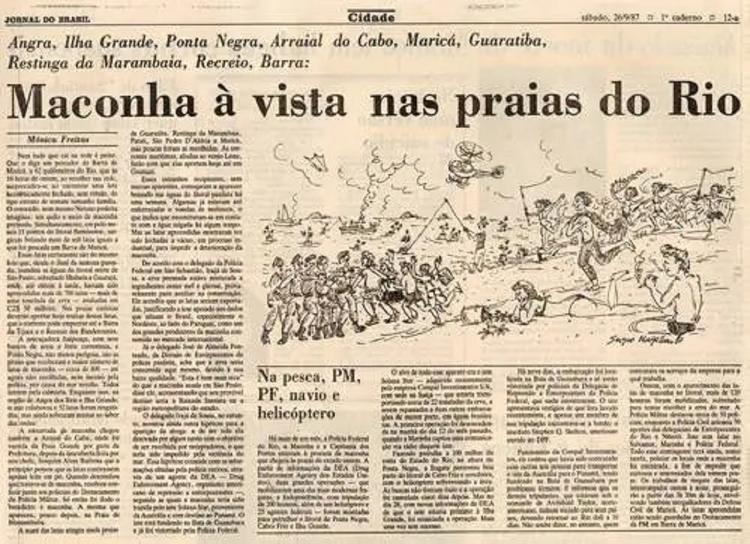Since two large plastic bags, tied to small plastic gallons and some life jackets, have been found on two beaches in Normandy, on the coast of France, in the past three weeks, the few inhabitants of the region’s small towns have been talking about nothing else.
And so are the many outsiders who have come from far away and were attracted by the news.
Everyone spends days commenting on the contents of those mysterious bags: kilos and more kilos of the purest cocaine, which ended up on those two beaches – no one knows how or where they came from, much less who was transporting them.
There are still no answers to the many questions in this case. But there are already some good clues.

COULD THEY COME FROM BRAZIL?
One of the clues indicates that, at some point in its trajectory to Europe, where it would be sold at million-dollar prices, since, according to the police, the drug is of the highest quality, the cocaine contained in those two plastic bags passed through Brazil – from where, most probably, it also departed.
The conclusion is evident because of an unquestionable detail: the life jackets, which, along with the empty jerry cans, were tied to the bags to allow them to float, are from a well-known Brazilian brand of marine safety equipment, Ativa, which, although famous, does not export them.

Therefore, the probability that those life jackets came from a non-Brazilian vessel is very small.
Although nothing prevents them from being put on a foreign boat, this is unlikely.
VEST FROM A SAILBOAT?
Most likely, the boat that carried the objects – drugs and life jackets – is Brazilian and small since this type of life jacket is not used on ships.
Classified as “Class 2”, the Brazilian brand life jackets are approved for use only in sheltered or coastal waters and on passenger boats, such as speedboats and sailboats.
And the most significant suspicions at the moment fall on a sailboat flying a Brazilian flag that would have crossed the Atlantic to transport the drugs to Europe – although the French police still do not know which boat it would have been.
Even less how those bags full of cocaine ended up in the sea off the French coast.
Or – which is much more likely – why they would have been deliberately thrown into the water, an equally easy deduction since nobody would have bothered to attach them to improvised floats if there was no apparent intention of throwing them overboard.
DID THEY THROW THEM INTO THE SEA AND RUN AWAY?
In principle, there are two hypotheses for this:
Either the boat carrying the cocaine could not approach the beaches to land the merchandise (perhaps due to the sea conditions on the day), or the crew members decided to get rid of the drugs because of some risk of being approached by the police – although no such pursuit or arrest of the boat took place in the region.
In both cases, the decision to deposit such a valuable cargo at sea (according to estimates, the drug found would be worth about US$19 million in the big European markets) would have been caused by a necessity of the traffickers.
It should not have been part of the group’s original plans, as it also seems clear when analyzing the precariousness of the floats: improvised gallons tied to life jackets objects that every boat has on board.
THEY DISCARDED THE BOATS
The plastic jerry cans (all medium-sized) were used for oil or chemical products, and the life jackets (colored, like all equipment of this type) were too flashy for an illegal operation, which, for this reason, should be as discreet as possible.
Another possibility, initially considered but already practically discarded, is that the drugs were being transported by a ship, inside a submerged compartment that exists in this case to capture water – and is increasingly used by traffickers for involuntary transport – or inside containers, which eventually fell into the sea and released their contents into the water.
But neither of the two alternatives would explain the floats tied to the bags.
NEAR THE BEACH OR IN THE OPEN SEA?
The most plausible is that the traffickers, on board a sailboat coming from South America (or, more specifically, from Brazil, as has frequently been happening), were forced to throw the drugs into the sea for some unknown reason.
And this may not have happened so close to the beaches where the two bags were found, but on the high seas, with the drugs being brought to the coast by sea currents.
For this reason, new bags may appear in the coming days for the attention of the police and the expectation of the “narcotourists,” as the outsiders are now called, who arrived on the region’s beaches in search of the cocaine that came from the sea.
POLICE X NARCOTOURISTS

Despite intense police patrols of Normandy’s nearly deserted beaches, more and more people have been seen wandering along the shore, looking for debris at the water’s edge or scanning the horizon with binoculars to find some new package of the drug.
This is much to the discomfort of residents, who do not take kindly to the presence of so many strangers in the region’s quiet little towns.
“They are strange people, walking on the beach in the early hours of the morning, looking at everything they find at the water’s edge,” says a resident of the small town of Réville, who prefers not to be identified.
“They look like addicts searching for drugs to calm them down.”
A similar phenomenon (but for a different reason) Europe experienced in 1988 when a ship carrying 5,000 brand new cars ran aground and sank on the Madalena beach in Portugal, leading hundreds of Portuguese to spend days on the beach in the hope of getting one of the cars.
OVERNIGHT RICHES
But the search undertaken by the “cocaine hunters” on the beaches of Normandy has another motive, besides eventually just satisfying their pleasure.
“A package like this can make you rich overnight,” one of the cocaine hunters explained to the French news program TF-1, indifferent to the constant monitoring by the police.
“It’s worth the risk.
IT CAN KILL YOU ON THE SPOT
The risk, in this case, is not only that of being arrested for drug possession (a crime that, in France, can result in a sentence of up to ten years in prison) but also of the life of the eventual consumers of the cocaine found on the region’s beaches, since, according to the police, it is quite pure, and therefore quite dangerous to health.
“A single dose of cocaine with this level of purity can be fatal and kill a person on the spot,” warns an expert on the subject, adding that four years ago, in another episode of cocaine arriving by the French sea (events that the French has dubbed “White Tides”), a young man died after ingesting a small portion of the drug found on the beach.
COCAINE QUALITY MAY BE THE CLUE
On that occasion, the packets of cocaine were found on the beaches of Brittany, a region neighboring Normandy, and added up to more than 1.5 cubic meters of the drug, also of the highest quality – which means that once processed and mixed with other substances, as is always the case, they would yield almost three times as much in the avid European market for narcotic consumption.
Ironically, however, it is the excellent quality of the cocaine that has now washed up on the beaches of Normandy that may give another good clue to its origin, for each “producer” usually has their own “recipe” – and the police have a way of tracing this, with the help of their colleagues in other countries.
Also, according to the French police, the traffickers who put the packets of cocaine inside the plastic bags and tied them to the floats may have left fingerprints or DNA traces on the packages, which would facilitate the identification of the traffickers. However, this depends on the cooperation of the countries suspected of being the origin of the drug, especially Brazil.
75% OF THE DRUG ARRIVES BY SEA
The cocaine traffic is overwhelmingly exploding in France.
Last year alone, 27.7 tonnes of the drug were seized, five times more than ten years ago.
According to the police, 75% of it came by sea from South America, especially Brazil, which has long been part of the international drug trafficking route.
To take the cocaine to Europe, the Brazilian traffickers use both ships, which often carry the drug unknowingly, mixed in with the cargo or hidden in the hull, and private sailboats or fishing boats, with enough autonomy to cross the ocean without refueling.
As it seems it was another one of them responsible for the uncomfortable surprise that arrived on the French beaches in the last weeks, causing the apprehension of the police, the tension of the residents, the expectation of the drug tourists, and the joy of those who are still trying to find some prohibited substance gently brought by the sea, as has happened in the past, in so many other places.
It remains to know which boat that was. Because where it came from is easy to deduce.
IN BRAZIL, THE CASE OF THE “BARCO DA LATA” (BOAT OF CANS)
In Brazil, the most famous case of drug dumpings at sea happened in the summer of 1988 in Rio de Janeiro, when a boat carrying 15,000 cans of cannabis dumped its unusual cargo right in front of the city’s beaches to escape from being caught by the police.
In doing so, he also made the bathers and surfers happy, who were euphoric as they saw cans and more cans of the then highly prized and high-quality herb arrive, brought by the waves.

The fact, which became eternalized as the “Summer of the Can”, caused a furor in the city, generated a rush to the beaches, and, as is now happening in France, showed the inability of the police to stop the offenders.
Some of them keep some of these cans (empty, obviously) until today as a trophy of the most original gift they have ever received from Yemanja, which marked an epoch in Rio de Janeiro and became even more folkloric than what is happening now on the northern coast of France.
With information from UOL

